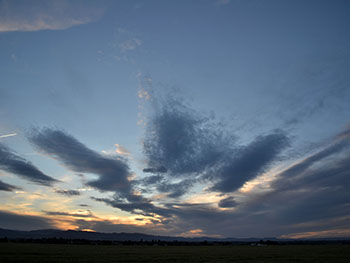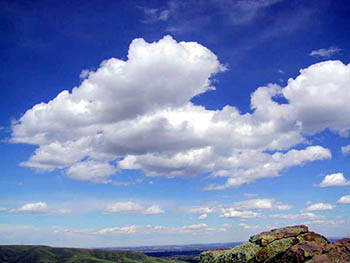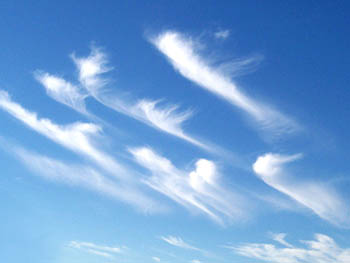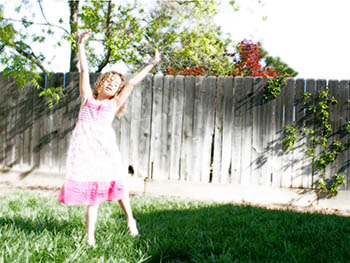SUBJECTS
GRADE
Show Results
Clouds

Lesson Summary
- Create dance movements with an object based on cloud types.
- Identify basic cloud types: cumulus, cirrus, and stratus.
- Learn how cloud types can predict weather conditions.
Lesson Plan and Procedure
Lesson Key Facts
- Grade(s): 3
- Subject(s): Dance, Science
- Duration of lesson: 40 minutes
- Author(s): Jana Shumway
Note: All the activities in this lesson will involve students in a partnership, each holding an end of a white sheet.
Experience/Identify
Have the students choose a partner. Pass out one large sheet to each partnership.
Play the song “Flying Things” by Peter Melnick.
Activity 1: Stratus Clouds
Have the partners kneel down on either side of the sheet.
Teacher: Stratus clouds float at a low level.
 Have the students wave the fabric up and down a few times, sending a wave of air to each other.
Have the students wave the fabric up and down a few times, sending a wave of air to each other.
Teacher: Stratus clouds can drift to create new and longer stratus clouds. Stand up and travel so that you are standing back to back with another person other than your partner. Now we have one long stratus cloud. A breath of wind shifts the stratus cloud.
Start at one end and send a ripple through the entire stratus cloud.
Teacher: Stratus clouds can be dark and gloomy and release rain.
Have the students shake the fabric, but keep it low.
Teacher: Stratus clouds can rest on the ground and become fog.
Get all groups close together and kneel down.
Teacher: Let’s go in the fog (or stratus cloud).
Have the students lift their arms up so that they are under the material or in the fog.
Teacher: Stratus clouds are thin and flat. Spread out, stretch out the fabric, and place it on the ground. Lie down past the ends. Stratus clouds are like a blanket covering parts of the earth. Move under the fabric so it’s covering you and your partner’s legs and kick your feet.
Activity 2: Cumulus Clouds
Teacher: Cumulus clouds are puffy.
Have the students stand up and puff the materials as they lift their arms up and down with their partner.
Teacher: Some look like cotton balls. Others look like cotton candy. And others look like cauliflower.
Have the kids make up three different types of puffs with their partners. Ideas may include run under fabric, jump during lifting, and so on.
Teacher: Cumulus clouds often form in good, sunny weather.
Have the students run and change directions with their partner while tilting the fabric sideways to catch the pleasant air.
Teacher: The bottoms of cumulus clouds are usually flat with the top part billowing in circular shapes.
Have the students go with another set of partners. Have one set keep the fabric low and flat while the other set puffs the fabric above.
Activity 3: Cirrus Clouds
Teacher: Cirrus clouds are feathery and wispy.
Have the partnerships hold the fabric in its middle section and turn while flapping the fabric up and down.
Teacher: They are cold and made of ice crystals.
Have the partnerships flap the sheet in a figure eight.
Teacher: They are the highest floating clouds, sometimes getting above 18,000 feet.
Have the students bend down low, scrunch their sheet together, and then throw it up high and, before they catch it, do a turn.
Teacher: Cirrus is named after the Latin word that means “curl of hair” and has a nickname of being a "mare’s tail" or "horse's tails."
Have the children hold the fabric by the corners of one end high over their head and run. Then on your signal, have them throw it over their heads, creating an arc.
Teacher: Cirrus clouds are signals that bad weather is coming.
Have the students whip the sheet violently.
Explore/Investigate
Play the song “Australia” by Cusco.
Repeat the above dance again but with a black light so fabric glows.
Look for moments when you can assess the students’ knowledge and ask them questions such as, What are cirrus clouds a sign of? (Answer: Bad weather.)
Create/Perform
Note: This activity can be saved for another day, depending on time.
Play the song “Eagle’s Path” by David Lanz and Paul Speer.
After the students have repeated the dance sufficiently to know the facts about the different cloud types, divide the class into three groups and have them create their own dances and distribute a card to each group, in which they show all the facts about one of the particular clouds assigned to their group. You may wish to type up the facts onto a small card to help ensure that they put all the facts in.
You can have the students viewing a group's dance guess which clouds they have and identify facts from the movements displayed. If the viewing students have not been able to guess all the facts, have the performers teach/explain what parts of their dances represented what fact.
Connect/Analyze
Show images of the three different types of clouds and assess the students' ability to remember the types of clouds and facts about the clouds from the performances.
Learning Objectives
- Identify characteristics of clouds that can be used to predict weather conditions.
- Recall and perform movement with a partner.
- Manipulate movement choices from already established movement.
- Create several different movement patterns and structures.
Utah State Board of Education Standards
This lesson can be used to meet standards in many grades and subject areas. We will highlight one grade’s standards to give an example of application.
Grade 3 Science with Engineering Education (SEEd)
- Standard 3.1.1: Analyze and interpret data to reveal patterns that indicate typical weather conditions expected during a particular season. Emphasize students gathering data in a variety of ways and representing data in tables and graphs. Examples of data could include temperature, precipitation, or wind speed. (ESS2.D)
Grade 3 Dance
- Standard 3.D.CR.3: Improvise and create a dance phrase, alone or with others, that expresses and communicates an idea or feeling.
- Standard 3.D.P.7: Recall movement sequences with a partner or in group dance activities.
Equipment and Materials Needed
- Images of various clouds
- Black light (optional, but very fun)
- Enough white satin tricot sheets for half the class or just white flat sheets
- Music tracks:
- “Eagles Path” by David Lanz and Paul Speer
- “Australia” by Cusco
- “Flying Things” by Peter Melnick
Additional Resources
- 3rd Grade SEEd Open Educational Resource Textbook: https://emedia.uen.org/courses/utah-oer-textbooks-3rd-grade-seed/view
- Predicting the Weather with Clouds: https://www.instructables.com/id/Predicting-Weather-with-Clouds/
- Weather Wiz Kids: https://www.weatherwizkids.com/weather-clouds.htm
Image References
Image 1: Shutterstock (https://www.shutterstock.com/image-photo/children-dancing-modern-group-choreography-scarfs-569097028).
Image 2: Colorado Clouds Blog (https://coclouds.com/wp-content/uploads/2013/06/hazy-stratus-cloud-sunset-2013-06-24.jpg).
Image 3: Wikimedia Commons (https://commons.wikimedia.org/wiki/File:Cumulus_clouds_in_fair_weather.jpeg).
Image 4: Wikipedia (https://en.wikipedia.org/wiki/Cirrus_cloud#/media/File:Cirrus_clouds2.jpg).
Image 5: "easter morning dancing" by Divine in the Daily is licensed with CC BY-ND 2.0.

www.education.byu.edu/arts/lessons
 Download
Download